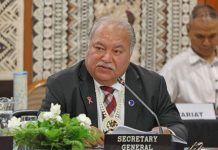Fourteen Pacific island nations will receive US$107 million to adapt their tuna-dependent economies as climate change pushes the fish farther from their shores, the Green Climate Fund announced Tuesday.
The fund’s largest grant-only project to date, the money will be used to create an advanced warning system to enable Pacific island nations to track changes in tuna migration and potentially pursue compensation when warming waters drive the fish from these countries’ exclusive economic zones.
“These are the countries that contribute the least to the climate crisis and now are going to lose a resource that they have collectively stewarded better than any other ocean basin,” said Jack Kittinger, senior vice president at Conservation International, the Arlington, Virginia-based nonprofit environmental organisation that led the research behind the grant. “This is the ultimate climate justice issue.”
The UN Framework Convention on Climate Change created the Green Climate Fund in 2010 as a financing mechanism to help developing countries reduce emissions and adapt to climate change.
Based in South Korea, the fund relies on contributions from wealthy countries. But President Donald Trump announced this month that he was rescinding US$4 billion in U.S commitments to the fund.
That decision, coupled with the U.S withdrawal from the Paris climate agreement, has rocked Pacific island nations, which are already disproportionately feeling the effects of rising seas and more ferocious and frequent storms.
Ludwig Kumoru, director of fisheries management at the Pacific Islands Forum Fisheries Agency(FFA), said Trump’s climate decisions underscored the need for Pacific-led solutions.
“We can’t just drop our guard because somebody has dropped out of the Paris agreement,” he said. “At the end of the day, if we don’t pay attention to climate change, it’s going to be the demise of all of us.”
Scientists have in recent years predicted another danger for Pacific island nations. They rely heavily on tuna fishing licenses and fees for much of their governmental revenue — in some cases, more than 80 percent — from companies fishing for tuna-consuming countries such as Japan, China, South Korea and the United States.
As oceans warm, these tuna stocks will be driven out of their exclusive economic zones (EEZs) and into the high seas, where fishing fleets will be able to scoop them up without having to pay for them.
“It’s a really big threat,” Kumoru said. “The bottom line is how much are our countries going to lose?”
Many Pacific island nations are minuscule in land size, but their EEZs are vast and rich in marine life. Between them, the recipients are the source of around one-third of the world’s tuna catch, especially skipjack, yellowfin, bigeye and albacore.
The grant will go to the Cook Islands, Fiji, the Federated States of Micronesia, Kiribati, the Marshall Islands, Nauru, Niue, Palau, Papua New Guinea, Samoa, the Solomon Islands, Tonga, Tuvalu and Vanuatu.
Their management of Pacific tuna stocks has been a rare conservation success story. In 1982, eight Pacific Island countries came together in Nauru to agree to comanage their fisheries and share the benefits.
Since then, the parties to the Nauru agreement — sometimes called the “OPEC of tuna” — have developed a system to regulate purse seine fishing, pool unpredictable tuna revenue and prevent overfishing, which has threatened bluefin tuna in particular.
“We have the most sustainable fisheries in the world in the Western and Central Pacific Ocean, not only the highest numbers of catch but the health of those populations are the best in the world for all the main tuna species,” said Beau Bigler, chief of the oceanic and industrial affairs division at the Marshall Islands Marine Resources Authority. “A major reason for this is the work done on the shoulders of small island developing states.”
In 2021, however, a study led by Conservation International’s Johann Bell and other scientists found that tuna caught in the EEZs of nine Pacific island nations and Tokelau, a territory of New Zealand, would plummet by an average of 20 percent by 2050 under a scenario of high greenhouse gas emissions, costing the 10 states roughly US$90 million per year in lost license revenue. Smaller Pacific island nations without other industries such as mining or logging could expect their revenue to plunge by almost one-fifth, denting their ability to provide basic services.
“It is a big alarm bell,” Bigler said.
Since then, Conservation International has been working to secure funds to provide a solution. Much of the US$107 million will go toward the advanced warning system, which will use large-scale genomic sequencing of tuna to better understand how populations are shifting due to warming oceans. The project has a seven-year timeline.
Kumoru said current models are too imprecise. A more detailed system would enable Pacific island nations to better anticipate tuna migration and its economic impacts, strengthen negotiations to retain economic benefits from tuna fisheries and potentially make claims for climate justice at the International Court of Justice or the United Nations’ Loss and Damage Fund.
“If we are going to lose this resource, how are we going to get something back?” he said. “Everything has to be evidence based.”
The grant also includes funding to boost tuna consumption in Pacific island nations as climate change diminishes the stocks of the coral reef fish traditionally eaten. It will expand the use of fish aggregation devices, which float offshore and help attract tuna and other large fish.
“We see it as the number one adaptation for coastal communities who have always been dependent on fish for food security,” Bell said.
Some of the funding will also go toward enabling Pacific island nations to receive more of the bycatch — or species unintentionally caught by fishing vessels — when they dock. Much of that bycatch is either discarded or taken back to the vessel’s home country.
The grant will be implemented by the Pacific Community, an international organisation that provides scientific and technical assistance to the Pacific region and includes the United States, Australia, New Zealand, France and the United Kingdom.














